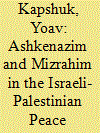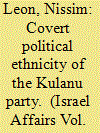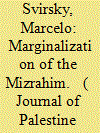| Srl | Item |
| 1 |
ID:
175503


|
|
|
|
|
| Summary/Abstract |
This paper examines the mechanisms which drive the different political attitudes of Israel’s two major Jewish groups – the Ashkenazim and the Mizrahim – vis-à-vis the Israeli-Palestinian peace process in the 1990s. The study argues that the economic liberalization reforms of the 1980s along with the subsequent Israel’s integration with the global economy are key drivers of the two groups’ opposing attitudes vis-à-vis the peace process. These processes benefited mainly the business classes, who are dominated by the Ashkenazim (originating from Europe). It was such benefit that drove Ashkenazim’s support for the Oslo Accords in the 1990s, which was seen as instrumental to the process of Israel’s integration with the global economy. Conversely, the same economic processes likely hurt lower-class members of Israeli Jewish society, most of whom are Mizrahim (originating from Muslim countries). In this context the settlements in the West Bank and Gaza provided them with an alternative source of welfare to buffer the negative impacts of the integration process. As a result most of the Mizrahim population opposed any peace deal that included the evacuation of settlements. Moreover, Mizrahim’s opposition to Oslo was strengthened by the association of Oslo with Israel’s global integration, which some evidence suggests mainly benefited the business classes.
|
|
|
|
|
|
|
|
|
|
|
|
|
|
|
|
| 2 |
ID:
149188


|
|
|
|
|
| Summary/Abstract |
The Israeli general elections of March 2015 saw the advent of a new middle-class party. Kulanu, headed by Moshe Kahlon, achieved 10 seats for its representatives in the Knesset (Israeli parliament). This article proposes that Kulanu be viewed not only as a middle-class party, but also as a new addition to the list of Mizrahi ethnic parties. Kulanu’s appearance on the political centre-stage in Israel rested, at least among the Jewish population, upon its ability to offer a political wavelength and series of political symbols of upwardly mobile ethnicity in Israel – first and foremost among them the elusive ethnicity of the Mizrahi middle class. Kulanu’s political ethnicity assured widespread legitimacy for its agenda as well as empathy on the part of the source of its power – the Mizrahi middle class.
|
|
|
|
|
|
|
|
|
|
|
|
|
|
|
|
| 3 |
ID:
186982


|
|
|
|
|
| Summary/Abstract |
This article explores the role Arab music has played in forming Mizrahi identity in contemporary Israeli cinema, focusing on the films “The Ballad of the Weeping Spring”, “Testimony” and “Three Mothers”, which second and third generation Mizrahi filmmakers born to Jewish immigrants from Arab and Muslim countries made in Israel. Using Arab music, these films display the vast array of historical and imaginary relations between the Jew and the Arab, West and East, Israel and the Middle East. Memory of the Arab-Jewish past is a place that cannot be revisited, even if one can travel to the geographical territory that appears to be a place of ‘origin.’ As members of the second and third generations born in Israel, these Mizrahi filmmakers cannot reclaim the Arab-Jewish past of which they never really were a part, and so they try to trace musical routes that will take them to places, histories and encounters with people they have not known before. The grounded certainty of their Mizrahi roots is replaced in the films by the contingencies of the routes that the music enabled.
|
|
|
|
|
|
|
|
|
|
|
|
|
|
|
|
| 4 |
ID:
190012


|
|
|
|
|
| Summary/Abstract |
This article investigates the institutional attitudes of the Histadrut (the General Organization of Workers in the Land of Israel) toward Palestine’s Middle Eastern Jews (Mizrahim) between 1920 and the late 1940s. Based on archival evidence and secondary sources, it argues that what Mizrahi workers experienced in their dealings with the Histadrut was not the result of random or unintended abuse but of a political culture that promoted social fragmentation and inequality. The corollary of this argument is that the Mizrahim who arrived immediately after 1948 found themselves thrown into a racial binary mold that had been in the making for about fifty years, beginning with the first waves of Zionist immigration to Palestine.
|
|
|
|
|
|
|
|
|
|
|
|
|
|
|
|
| 5 |
ID:
167158


|
|
|
|
|
| Summary/Abstract |
This article examines how Mizrahim perceive their media representation on Israeli television. Using Karl Jaspers’ psychological theory of boundary situations, the article seeks to explain the seeming disparity between the negative depiction of Mizrahim on Israeli TV and Mizrahi consumption of these representations. Having conducted in-depth semi-structured interviews with 25 individuals, the article found that most of the interviewees were well aware of their negative representation on Israeli TV yet used various interpretive strategies, stemming from ‘media boundary situations,’ to deal with this prejudice.
|
|
|
|
|
|
|
|
|
|
|
|
|
|
|
|